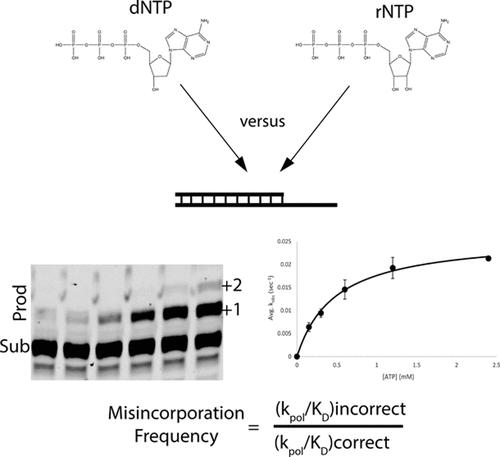当前位置:
X-MOL 学术
›
Biochemistry
›
论文详情
Our official English website, www.x-mol.net, welcomes your
feedback! (Note: you will need to create a separate account there.)
Ribonucleotide Misincorporation and Reverse Transcriptase Activities of Plasmodium falciparum Apicoplast DNA Polymerase
Biochemistry ( IF 2.9 ) Pub Date : 2022-11-08 , DOI: 10.1021/acs.biochem.2c00450 Nicholas S Nieto 1 , Eric E Parrott 1 , Scott W Nelson 1
Biochemistry ( IF 2.9 ) Pub Date : 2022-11-08 , DOI: 10.1021/acs.biochem.2c00450 Nicholas S Nieto 1 , Eric E Parrott 1 , Scott W Nelson 1
Affiliation

|
Plasmodium falciparumis the most common and harmful causative agent of malaria worldwide. As a member of the phylum Apicomplexa, P. falciparum is characterized by the presence of a unique and essential organelle called the apicoplast. Reminiscent of an algal chloroplast, the apicoplast possesses its own genome, which is maintained by a single apicoplast DNA polymerase (apPol). Ribonucleotides misincorporated into the genome are among the most common lesions encountered by DNA polymerases, and the ability to replicate past these lesions varies widely among characterized enzymes. Here, we have investigated the ribonucleotide (rNTP) misincorporation frequency of apPol and determined its reverse transcriptase (RT) activity across templating ribonucleotides. Pre-steady-state kinetic experiments indicate that apPol does not have an unusually high discrimination between deoxy and ribonucleotides, with frequencies ranging between 104 and 106 depending on the identity of the ribonucleotide. Once incorporated into its template, apPol can replicate across ribonucleotides using its RT activity, but extension of a deoxynucleotide basepaired with the ribonucleotide is slow relative to a canonical basepair. Exonuclease assays indicate that apPol proofreads ribonucleotides an order of magnitude faster than extension, suggesting that most, but not all, misincorporated ribonucleotides will be excised. Although the components have not been identified, ribonucleotide excision repair or other tolerance mechanisms may exist in the P. falciparum apicoplast, and more targeted proteomic efforts will be needed to elucidate them.
中文翻译:

恶性疟原虫顶端体 DNA 聚合酶的核糖核苷酸错误掺入和逆转录酶活性
恶性疟原虫是全世界最常见和最有害的疟疾病原体。作为 Apicomplexa 门的成员,P. falciparum其特征是存在一种独特且必不可少的细胞器,称为顶端质体。让人想起藻类叶绿体,顶端质体拥有自己的基因组,由单个顶端质体 DNA 聚合酶 (apPol) 维持。错误掺入基因组的核糖核苷酸是 DNA 聚合酶遇到的最常见的损伤之一,并且复制过去这些损伤的能力在不同的特征酶之间差异很大。在这里,我们研究了 apPol 的核糖核苷酸 (rNTP) 错误掺入频率,并确定了其跨模板核糖核苷酸的逆转录酶 (RT) 活性。前稳态动力学实验表明 apPol 在脱氧和核糖核苷酸之间没有异常高的区分度,频率范围在 10 4和 10 6之间取决于核糖核苷酸的身份。一旦合并到其模板中,apPol 就可以使用其 RT 活性在核糖核苷酸之间进行复制,但与核糖核苷酸配对的脱氧核苷酸碱基的延伸相对于规范碱基对来说是缓慢的。核酸外切酶测定表明 apPol 校对核糖核苷酸的速度比延伸快一个数量级,这表明大多数(但不是全部)错误掺入的核糖核苷酸将被切除。尽管尚未确定这些成分,但恶性疟原虫顶端体中可能存在核糖核苷酸切除修复或其他耐受机制,需要更有针对性的蛋白质组学努力来阐明它们。
更新日期:2022-11-08
中文翻译:

恶性疟原虫顶端体 DNA 聚合酶的核糖核苷酸错误掺入和逆转录酶活性
恶性疟原虫是全世界最常见和最有害的疟疾病原体。作为 Apicomplexa 门的成员,P. falciparum其特征是存在一种独特且必不可少的细胞器,称为顶端质体。让人想起藻类叶绿体,顶端质体拥有自己的基因组,由单个顶端质体 DNA 聚合酶 (apPol) 维持。错误掺入基因组的核糖核苷酸是 DNA 聚合酶遇到的最常见的损伤之一,并且复制过去这些损伤的能力在不同的特征酶之间差异很大。在这里,我们研究了 apPol 的核糖核苷酸 (rNTP) 错误掺入频率,并确定了其跨模板核糖核苷酸的逆转录酶 (RT) 活性。前稳态动力学实验表明 apPol 在脱氧和核糖核苷酸之间没有异常高的区分度,频率范围在 10 4和 10 6之间取决于核糖核苷酸的身份。一旦合并到其模板中,apPol 就可以使用其 RT 活性在核糖核苷酸之间进行复制,但与核糖核苷酸配对的脱氧核苷酸碱基的延伸相对于规范碱基对来说是缓慢的。核酸外切酶测定表明 apPol 校对核糖核苷酸的速度比延伸快一个数量级,这表明大多数(但不是全部)错误掺入的核糖核苷酸将被切除。尽管尚未确定这些成分,但恶性疟原虫顶端体中可能存在核糖核苷酸切除修复或其他耐受机制,需要更有针对性的蛋白质组学努力来阐明它们。















































 京公网安备 11010802027423号
京公网安备 11010802027423号